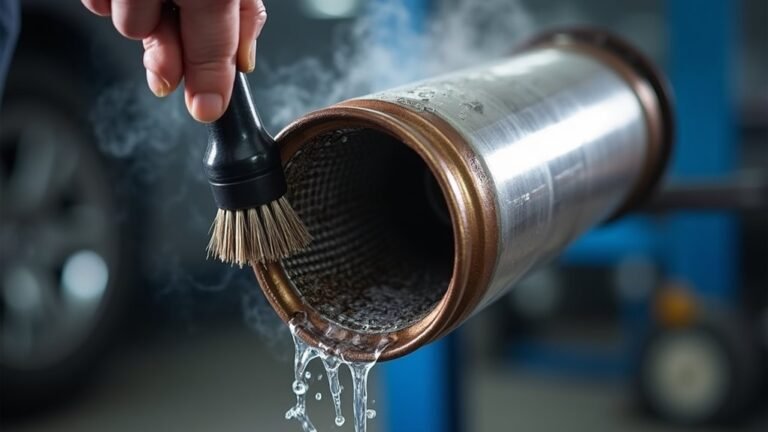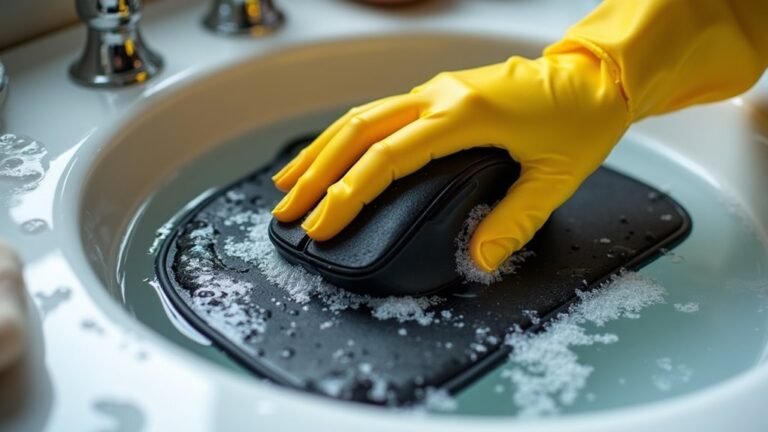While most car owners know their spark plugs need regular care, many don't know that cleaning them can help them last twice as long and make their engine run better. According to Mike Allen, Popular Mechanics' senior auto editor, "A dirty spark plug can cause your engine to waste gas and run rough – cleaning them is one of the simplest ways to boost performance." We'll show you the best ways to safely clean spark plugs, whether you're dealing with light dirt or tough buildup. If your car is having trouble starting, isn't running smoothly when idle, or using more gas than usual, cleaning your spark plugs might be the fix your engine needs.
Simple Plug Maintenance Basics

While maintaining spark plugs might seem intimidating at first, it's actually a straightforward process that can greatly extend their lifespan.
We'll want to inspect them every 30,000 miles, looking for fouling plugs that show signs of buildup.
When it's time to clean the spark plug, we'll use a wire brush or spark plug cleaners, followed by applying a minimal amount of grease to prevent corrosion before installation.
Let's look at what we need to know when cleaning spark plugs, including both the essential steps and common mistakes to avoid.
We'll guide you through the proper cleaning techniques, from safely removing the plugs to applying the right cleaning materials and checking the gap measurements.
Whether you're dealing with light carbon deposits or heavy buildup, we've got detailed tips to help you maintain your spark plugs effectively and safely.
Things to Do When Cleaning Spark Plugs
Properly cleaning spark plugs is important for maintaining peak engine performance and fuel efficiency. The process requires careful attention to detail and following specific safety protocols to guarantee both effective cleaning and prevention of damage to these essential engine components. While basic cleaning can be accomplished with common tools, it's important to approach the task methodically and with the appropriate safety precautions in place.
- Allow engine to fully cool – Prevents potential burns and guarantees safe handling during removal and cleaning
- Remove plugs carefully – Use correct socket size and gentle pressure to avoid damage to threads
- Inspect plug condition – Check for excessive wear, damage, or deposits to determine if cleaning is appropriate
- Clean with appropriate tools – Use wire brush or sandpaper gently on electrodes and threads, avoiding the porcelain
- Check gap measurement – Verify and adjust the electrode gap to match manufacturer specifications
- Apply anti-seize compound – Put small amount on threads to prevent future corrosion
- Reinstall correctly – Tighten to proper torque specifications using a torque wrench
- Test engine operation – Start engine to guarantee proper installation and function
Things to Avoid When Cleaning Spark Plugs
When cleaning spark plugs, it's essential to use gentle techniques that won't compromise their functionality or structural integrity. Proper maintenance can extend the life of spark plugs and guarantee peak engine performance, but using incorrect cleaning methods can cause permanent damage and potentially lead to engine problems.
- Abrasive materials (sandpaper, wire brushes): Creates scratches on the porcelain surface that attract new deposits and can compromise insulation.
- Anti-seize compound on new plugs: Interferes with pre-existing coating and can result in over-tightening during installation.
- Excessive heat application: Can warp or damage the spark plug's internal components and compromise its performance.
- Harsh chemical cleaners: Leave behind residues that interfere with proper spark generation and electrical conductivity.
- Gap adjustment negligence: Failing to verify proper electrode spacing after cleaning can lead to poor engine performance.
- Pressure washers or high-pressure air: Can force debris deeper into the plug or damage delicate components.
- Metal tools on electrode tips: Can bend or break the electrodes, rendering the spark plug useless.
- Prolonged soaking: Extended exposure to any cleaning solution can lead to internal contamination.
Steps
Cleaning spark plugs is an essential maintenance task that helps maintain engine performance and fuel efficiency. When spark plugs become dirty or corroded, they can cause misfires, rough idling, and decreased power output.
Regular cleaning can extend their lifespan and guarantee peak combustion in your engine.
Step 1: Allow the engine to cool completely before beginning work
Step 2: Remove the ignition coil or cable from each spark plug
Step 3: Use a socket wrench to carefully unscrew and remove the spark plugs
Step 4: Inspect each plug for signs of wear, damage, or buildup
Step 5: Gently clean the plugs using 220-grit sandpaper for surface deposits
Step 6: Use a wire brush to clean the threads, avoiding the porcelain insulator
Step 7: Check the spark plug gap with a specialized gap tool
Step 8: Apply a small amount of anti-seize grease to the threads
Step 9: Carefully reinstall each spark plug and tighten to proper specifications
Step 10: Reconnect the ignition coil or cable
Step 11: Start the engine to verify proper operation
Final Thoughts
Regular spark plug maintenance is one of the smartest investments you can make in your vehicle's health.
We recommend cleaning spark plugs periodically using a spark plug cleaner or gentle methods, but don't hesitate to replace new plugs when needed.

Maintaining clean spark plugs is essential for peak engine performance and fuel efficiency. While the cleaning process requires attention to detail and proper safety precautions, it's a manageable task for many DIY mechanics.
Regular inspection and cleaning can greatly extend the life of your spark plugs, potentially saving you money and preventing engine issues down the road.
If you're unsure about tackling spark plug maintenance yourself, don't hesitate to consult a professional mechanic. However, with the right tools, careful attention to manufacturer specifications, and proper cleaning techniques, you can keep your spark plugs in top condition.
Remember to always prioritize safety, work with a cool engine, and replace plugs that show signs of serious wear or damage.
Take the initiative to check your spark plugs today – your engine will thank you with improved performance, better fuel economy, and more reliable starts.
Whether you choose to clean or replace them, maintaining your spark plugs is a valuable investment in your vehicle's longevity.






